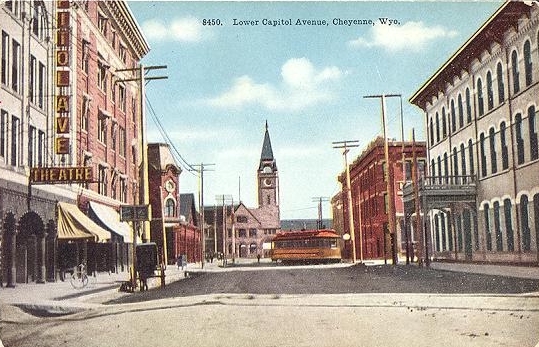
Lower Capitol Ave.
Above scene looking towards Union Pacific Station, Capitol Avenue Theater on Left, 5 story building immediately
past theater is First National Bank,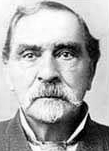 beyond that with the clock is the Burlington Depot; on right, side entrance to
the Inter-Ocean Hotel,
now the site of the Hynds Building (see 1920's photo below).
beyond that with the clock is the Burlington Depot; on right, side entrance to
the Inter-Ocean Hotel,
now the site of the Hynds Building (see 1920's photo below).
Right, Barney Ford, owner of the Inter-Ocean Hotel
Prior to the construction of the
Plains Hotel in 1910, pictured at bottom of the page, the leading hotel in Cheyenne was the Inter-Ocean Hotel constructed by
Barney Ford (1827-1902)*, photo to right. The Inter-Ocean was built by Ford after an earlier hotel burned in 1870.
In1903 the Inter-Ocean
hosted, among others, President T. Roosevelt on his visit to Cheyenne.
The Inter-Ocean also acted as a principal watering hole in Cheyenne. Tom
Horn observed in his infamous conversations with Joe LeFors (see discussion of
Horn trial .):
"If you go to the Inter-Ocean to sit down and talk a few minutes
some one comes in and says, 'Let us have a drink,' and before you know it
you are standing up talking, and my feet get so [expletive deleted] tired it
almost kills me. I am 44 years, 3 months, and 27 days old, and if I get killed
now I have the satisfaction of knowing I have lived about fifteen ordinary lives."
Indeed, after Horn's statements to LeFors, Horn was arrested in the bar of the
Inter-Ocean.
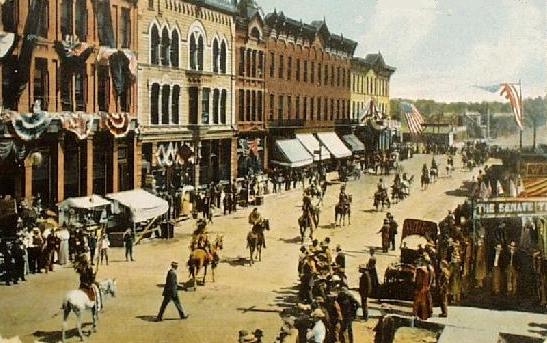
Indians, Frontier Day, 16th Street, approx. 1907
Down and across the street from the viewer is
the Inter-Ocean Hotel. The term "Frontier Days" with an "s" was not adopted until
1915. At the extreme right of the photo is another famous "watering hole" of Cheyenne, the
Senate Bar, owned by "Shorty" Evans. Evans advertised his establishment as "The only
second-class saloon in the city." He additionally claimed he sold "The beer that made
Milwaukee jealous." H. P. Hynd, who later built a bank building on the site of the
Inter-Ocean, also owned a saloon which was occassionally frequented by Tom Horn.
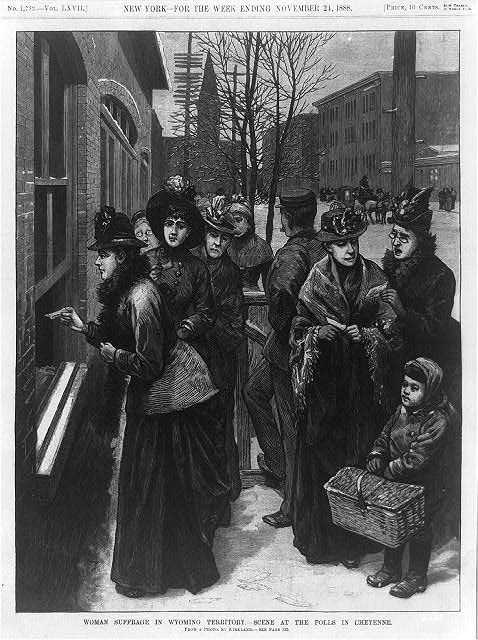
"Shocking" view of women actually voting in Cheyenne, Wyoming Territory,
is from an eastern tabloid, Leslie's Illustrated News, November 1888.)
Ford started life as a slave in Virginia*. His mother was killed during an
escape attempt when Ford was 17 or 18. He himself was able to escape, went to Nicaragua, where he ran two hotels.
His "United States Hotel and Restaurant" was destroyed when the city was
bonbarded. After the destruction of the hotel he returned to Chicago and then
moved to Colorado in 1860 where he staked a mining claim southeast of
present day Breckinridge. Since Blacks were not permitted to own land in their
own name the claim was placed in the name of his lawyer who promptly stole ownership
of the claim and had Ford evicted. The location was subsequently known as
"Nigger Hill" until 1964 when renamed "Barney Ford Hill."
After the eviction Ford
engaged in the restaurant and hotel business. Ford also owned an
Inter-Ocean Hotel on the corner of 16th and Blake Street in the
"LoDo" section of Denver. At the time the Lower Downtown was the center of Denver commerce, but after the turn of the
century slowly declined becoming an area in which one would literally have to step
over the recumbent winos in doorways. In the 1970's the Denver Inter-Ocean was pulled down before
the area has its present resurgence as a trendy area for yuppies. Ford is generally credited with
precluding the Colorado Consitution from eliminating sufferage for Blacks by successfully
lobbying Congress against statehood until the proposed Constitution protected
the right to vote. In contrast, Wyoming's statehood was delayed because of
its refusal to eliminate universal sufferage. In 1898 Ford was named to the
Denver Social Register, the first Black to be so honored. By the time of his death in 1902,
Ford had amassed a fortune of over $500,000 in 1902 dollars. Today, a brass plaque on
a wall on Blake Street near Coors Field, makes note of Ford and his Inter-Ocean hotel.
* Webmaster's Notes: Various dates and locations of birth are given for Ford,
from 1822 to 1827 with place of birth being given by different sources as
Virginia or South Carolina. Records were generally not kept for slaves.
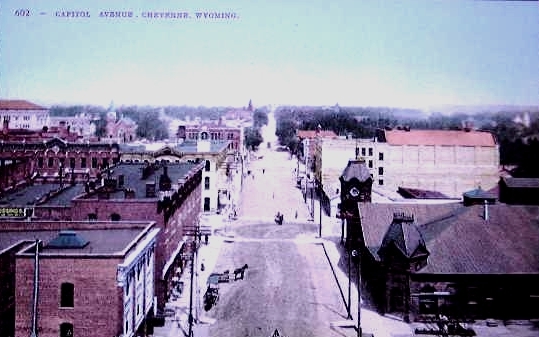
Tinted view of Capitol Avenue, approx. 1907, photo by J. E. Stimson
Opposite view from that of Lower Capitol Avenue above. Scene is from tower of railroad station, looking towards 16th (now, Lincolnway)
and in the distance the capitol. Burlington Depot on right. On the left, first building is
the Hotel Becker, next is the Normandie Hotel. On the corner of 16th is the Inter-Ocean and
on the corner of 17th is the Cheyenne Opera House. Compare
with identical view in the 1920's below.
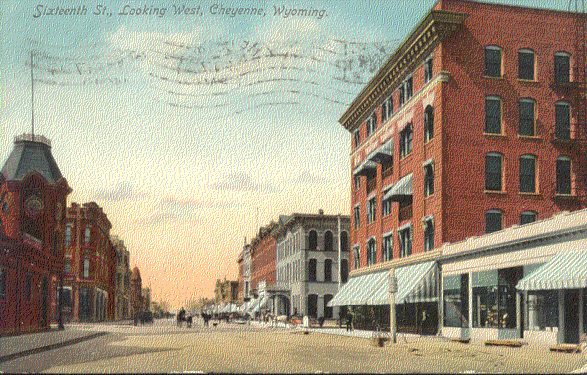
16th Street (Lincolnway), 1909, looking west at intersection with Capitol Ave.
The photograph was taken from the south side of the present location of the
Plains Hotel. Compare with photo immediately below. Five story building on right (north side of street) is First National Bank.
Across Capitol, still on north side, the gray building on the corner is the Inter-Ocean Hotel.
Ornate brick building with small tower on southeast corner (left) is Burlington Passenger Depot. On the southwest corner
is the Kelley Mercantile Co., purveyors of groceries, fruits and produce.
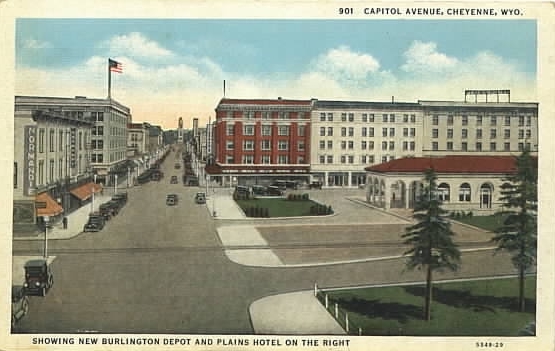
Capitol Ave., 1920's.
Compare with 1910 view taken from
same location. Both the old Burlington Depot and the Inter-Ocean are gone. The Inter-Ocean burned and the Hynds Building,
built by Harry P. Hynds,
is on its site. The Hynds Building, opened in 1920, was designed by William R. Dubois, discussed on the next page. The
building housed until 1964 the American National Bank now located on 20th and Capitol.
A comparison with the 1909 view of 16th reflects that the one-story building next to First National Bank
has been replaced.
Compare above scenes with 1919 view below
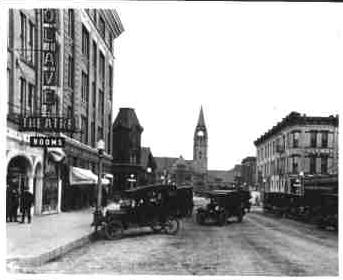
Cheyenne 1919
As indicated by the above photos, Cheyenne was
a very modern city, as confirmed by Emily Post in her description of her 1915
motor journey from New York to Denver:
If you think Cheyenne is a Buffalo Bill Wild West town, as we did, you
will be much disappointed, though it may be well not to show the
progressive citizens of that up-to-date city that you hoped they
were still galloping along wooden sidewalks howling like coyotes!
I thought that Celia and E.M. [Post's traveling companions] looked distinctly grieved at the sight
of smooth laid asphalt, wide-paved sidewalks, imposing capitol and modern buildings.
Even the brand-new Plains Hotel was accepted by both of them in much the same spirit
that a child who thought it was going to the circus and found itself at a museum of art, would accept the compensation of a nice hot supper instead of peanuts and red lemonade. . . The west of yesterday was no longer to be found in Cheyenne!
On one day in the year though, they have a Frontier Days Celebration---when,
like in the midnight hour of the Puppen Fee, the West that was comes
back to life. There are wonderful exhibits of "bronco busting" and rope
throwing, and all the features of county fair, horse show, and wild west
show in one.
Photo to right by J. E. Stimson
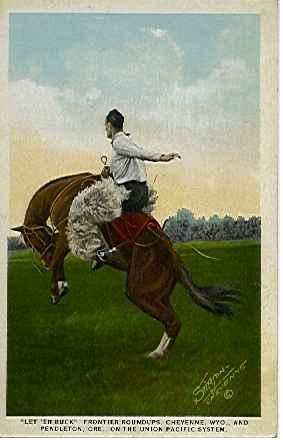
Joseph Elam Stimson was the official photographer for the
Union Pacific in Cheyenne from 1889 to 1903. A large collection of his photographs are
held by the American Heritage Center of the University of Wyoming. Other photographs are
held by the Wyoming State Museum and some are on display in the Old Governor's Mansion. Other
examples of his work will be found on the Chugwater and
Rudafeha Mine pages.
In contrast to Miss Post's comments, always the epitome of politeness, were the
comments of James Montgomery Flagg, primarily noted as the artist who created
the World War I Uncle Sam, "I want you!" poster, on his 1925 honeymoon trip
across the continent:
The roads are getting worse again,
and I hate to look at them, even when visible. We went thro Laramie to
Cheyenne. The street around the Plains Hotel was entirely torn up, and the
shabbiness, the dust, and the hard day's ride all combined to make me laugh
sardonically at the seriousness with which Cheyenne took itself.
As everyone knows, it is the scene of the big yearly rodeo, and no one
talks of anything else the year around I suspect. The post cards are all
on one subject---a horse giving an imitation of interpretive dancing, and
a cow person leaving his saddle for the plains at once!
I bought a couple of silk bandanas in a haberdashery, and the proprietor,
when I told him I wanted to get some fried chicken to take to the M.Q.["Motor Queen", the
reference to his new bride], who was then sleeping exhaustedly at the hotel,
at once left his store flat and, without his hat, escorted me to several
cafes to help find the chicken. That impulsive friendliness made me forget
the mood I arrived in and think kindly of Cheyenne.

Plains Hotel, Cheyenne, 1929
The red brick building (at the right in the photo) across the street from the Plains Hotel is now the location
of the Grier Furniture Company. At the time of the photo, it housed Hobbs, Huckfeldt and Finkbiner (later Hobbs and Finkbiner)
furniture and funeral directors. The practice of combining furniture sales and undertaking in
Wyoming was not all that unusual. For a discussion of the subject see
History of the Mortuaries and Funeral Homes of Riverton.
The hotel, now known
as the "Historic Plains Hotel", was designed by William R. Dubois, discussed on the
next page. The Plains Hotel has served as a meeting place since its construction and served
as the founding location for the Union Pacific Employees Clubs which started in Cheyenne and now has
branches throughout the system. The Hotel is allegedly haunted
by the ghost of an individual pushed from a fourth floor window.
Cheyenne Photos continued on next page.
|